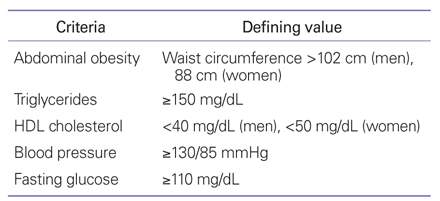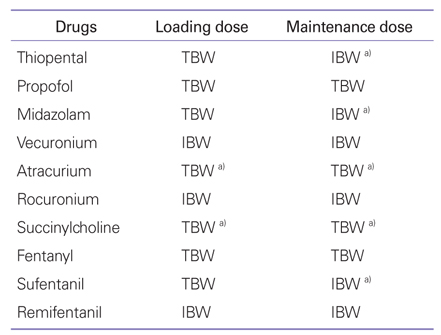 |
 |
- Search
| J Korean Med Assoc > Volume 55(10); 2012 > Article |
Abstract
Obesity, that is, having a body mass index (BMI) >30 kg/m2, has increased dramatically and became the most single most common preventable cause of death in South Korea. In the end, obesity results in metabolic syndrome, which includes abdominal obesity, increased triglycerides, decreased high-density lipoprotein, hypertension, and impaired glucose tolerance. Nonsurgical methods for obesity treatments include dietary therapy, exercise counseling, behavioral therapy, psychiatric therapy, and pharmacotherapy. Surgical methods for obesity treatments, laparoscopic gastric banding and Roux-en-Y gastric bypass, are commonly performed for obese patients, particularly those with a BMI of 40 kg/m2 or at BMI more than 30 kg/m2 with accompanying diseases related to metabolic syndrome such as hypertension, type 2 diabetes, hypercholesterolemia, asthma, angina, other cardiopulmonary diseases, infertility, polycystic ovary, urinary incontinence, severe arthritis, or Pickwickian syndrome. Preoperative evaluation for bariatric surgery should focus on airway management, sleep apnea history, use of a continuous positive airway pressure device, and comorbid systemic diseases. Special consideration and pharmacokinetic knowledge is needed for the choice and dose of the anesthetic agents as well as postoperative pain control, patient monitoring, fluid intake, and surgical complications. Obesity is a disease. Appropriate surgical intervention and peri-operative anesthetic care for bariatric surgery will increase the safety and satisfaction of obese patients and will finally provide a better quality of life for our society.
References
1. Hubbard VS, Hall WH. Gastrointestinal surgery for severe obesity. Obes Surg 1991;1:257-265.
2. Pories WJ, Dohm LG, Mansfield CJ. Beyond the BMI: the search for better guidelines for bariatric surgery. Obesity (Silver Spring) 2010;18:865-871.
3. Hutter MM, Randall S, Khuri SF, Henderson WG, Abbott WM, Warshaw AL. Laparoscopic versus open gastric bypass for morbid obesity: a multicenter, prospective, risk-adjusted analysis from the National Surgical Quality Improvement Program. Ann Surg 2006;243:657-662.
4. Gentileschi P, Kini S, Catarci M, Gagner M. Evidence-based medicine: open and laparoscopic bariatric surgery. Surg Endosc 2002;16:736-744.
5. Han SM, Kim WW. Early management of type 2 diabetes mellitus after sleeve gastrectomy in morbid obesity. J Korean Surg Soc 2005;69:304-309.
6. Liberopoulos EN, Mikhailidis DP, Elisaf MS. Diagnosis and management of the metabolic syndrome in obesity. Obes Rev 2005;6:283-296.
7. Patil SP, Schneider H, Schwartz AR, Smith PL. Adult obstructive sleep apnea: pathophysiology and diagnosis. Chest 2007;132:325-337.
8. Chung SA, Yuan H, Chung F. A systemic review of obstructive sleep apnea and its implications for anesthesiologists. Anesth Analg 2008;107:1543-1563.
9. Lopez-Jimenez F, Bhatia S, Collazo-Clavell ML, Sarr MG, Somers VK. Safety and efficacy of bariatric surgery in patients with coronary artery disease. Mayo Clin Proc 2005;80:1157-1162.
10. Collazo-Clavell ML, Clark MM, McAlpine DE, Jensen MD. Assessment and preparation of patients for bariatric surgery. Mayo Clin Proc 2006;81:10 Suppl. S11-S17.
11. Passannante AN, Rock P. Anesthetic management of patients with obesity and sleep apnea. Anesthesiol Clin North America 2005;23:479-491.
12. Bostanjian D, Anthone GJ, Hamoui N, Crookes PF. Rhabdomyolysis of gluteal muscles leading to renal failure: a potentially fatal complication of surgery in the morbidly obese. Obes Surg 2003;13:302-305.
13. Collier B, Goreja MA, Duke BE 3rd. Postoperative rhabdomyolysis with bariatric surgery. Obes Surg 2003;13:941-943.
14. Juvin P, Lavaut E, Dupont H, Lefevre P, Demetriou M, Dumoulin JL, Desmonts JM. Difficult tracheal intubation is more common in obese than in lean patients. Anesth Analg 2003;97:595-600.
15. Ezri T, Gewurtz G, Sessler DI, Medalion B, Szmuk P, Hagberg C, Susmallian S. Prediction of difficult laryngoscopy in obese patients by ultrasound quantification of anterior neck soft tissue. Anaesthesia 2003;58:1111-1114.
16. Jense HG, Dubin SA, Silverstein PI, O'Leary-Escolas U. Effect of obesity on safe duration of apnea in anesthetized humans. Anesth Analg 1991;72:89-93.
17. El-Dawlatly AA, Al-Dohayan A, Abdel-Meguid ME, El-Bakry A, Manaa EM. The effects of pneumoperitoneum on respiratory mechanics during general anesthesia for bariatric surgery. Obes Surg 2004;14:212-215.
18. Sprung J, Whalley DG, Falcone T, Wilks W, Navratil JE, Bourke DL. The effects of tidal volume and respiratory rate on oxygenation and respiratory mechanics during laparoscopy in morbidly obese patients. Anesth Analg 2003;97:268-274.
19. Egan TD, Huizinga B, Gupta SK, Jaarsma RL, Sperry RJ, Yee JB, Muir KT. Remifentanil pharmacokinetics in obese versus lean patients. Anesthesiology 1998;89:562-573.
20. Ogunnaike BO, Jones SB, Jones DB, Provost D, Whitten CW. Anesthetic considerations for bariatric surgery. Anesth Analg 2002;95:1793-1805.
21. De Baerdemaeker LE, Jacobs S, Den Blauwen NM, Pattyn P, Herregods LL, Mortier EP, Struys MM. Postoperative results after desflurane or sevoflurane combined with remifentanil in morbidly obese patients. Obes Surg 2006;16:728-733.
22. Illing L, Duncan PG, Yip R. Gastroesophageal reflux during anaesthesia. Can J Anaesth 1992;39(5 Pt 1):466-470.
23. Sharma SK, McCauley J, Cottam D, Mattar SG, Holover S, Dallal R, Lord J, Danner O, Ramanathan R, Eid G, Schauer P. Acute changes in renal function after laparoscopic gastric surgery for morbid obesity. Surg Obes Relat Dis 2006;2:389-392.
- TOOLS
-
METRICS

-
Related articles in
J Korean Med Assoc -
Management of post-cardiac arrest syndrome2023 September;66(9)
Recent trends in the management of anterior knee pain2023 August;66(8)
Endoscopic treatment for early gastric cancer2022 May;65(5)
Endoscopic diagnosis of early gastric cancer2022 May;65(5)
Pharmacological management of muscle spasticity2022 February;65(2)








